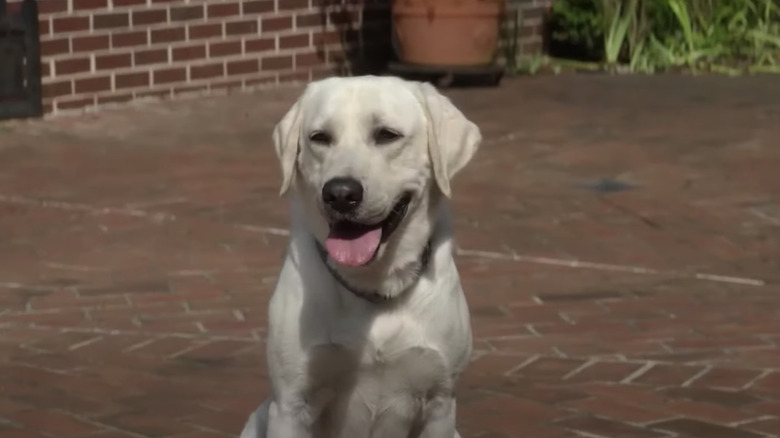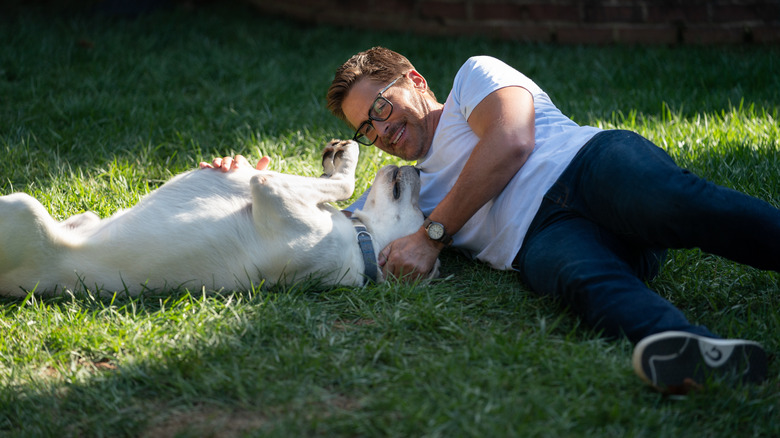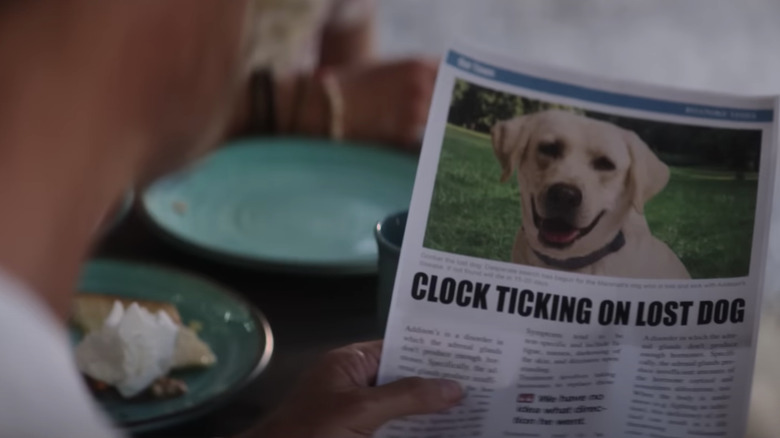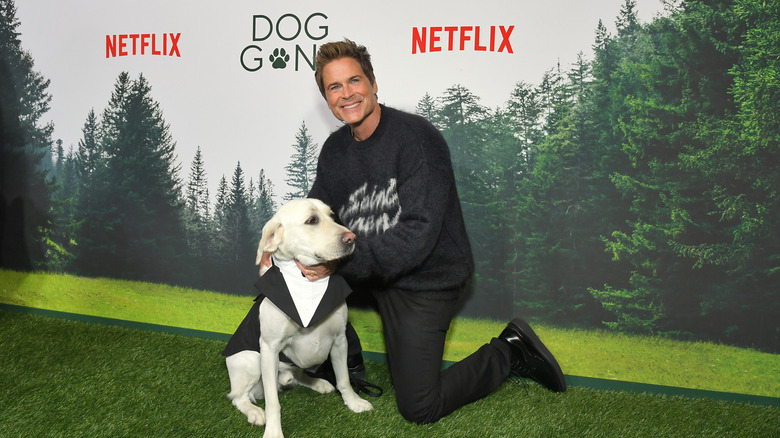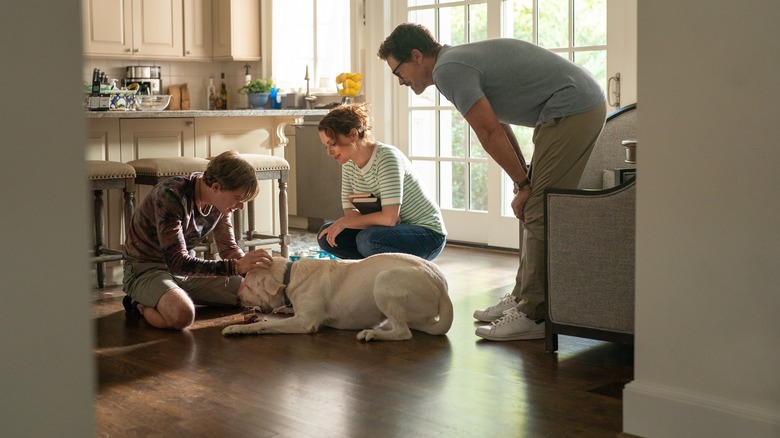What Dog Gone Got Right And Wrong About The Real Story
One for animal lovers, "Dog Gone" is a 2023 Netflix release based on the true story of a lost dog named Gonker, and the harrowing journey to try and bring him home. Making the journey even more urgent is the fact that Gonker has a potentially fatal illness, and his family needs to find him and get him his medicine before it is too late.
But the story goes much deeper, showing how looking for Gonker strengthened the bond between a father, John Marshall (Rob Lowe), and his son, Fielding (Johnny Berchtold). As a young man, Fielding is a bit aimless in life, and in one poignant moment in the film, John tells his son, "You worry about Gonker because you love him and he's lost. That's why I worry about you." There have been a number of successful dogs in Hollywood history, and now the story of Gonker is tugging at the audience's heartstrings everywhere. And you don't need to be a pet owner to be moved by it, because underneath the tale of the lost pooch, there is the heartwarming story of a family growing stronger together in the face of a crisis.
Based on the successful book by Pauls Toutonghi — also inspired by the true story and real family — "Dog Gone" maintains elements of what really happened, while also using a bit of dramatic and artistic license for the purpose of the film. Here's what "Dog Gone" got right and wrong about the real-life events.
Is Dog Gone autobiographical?
At the heart of "Dog Gone" is a relatable concept — particularly for pet owners — as it is likely they've either had to chase after their own pets, or are terrified of losing them. As it turns out, the author of "Dog Gone" didn't go through the harrowing events of the story himself, but ended up being a messenger to share the true story with the world. Toutonghi didn't have to look too far for the story, however, as it was his wife, Peyton Marshall (played as Ginny by Kimberly Williams-Paisley in the film) whose real-life dog went missing.
The story of Gonker's journey was told and retold by Ginny, Peyton's mother, and once Toutonghi heard it, he knew it would make a great book. As Toutonghi explained to Lewis and Clark: "This was the Marshall's famous family story. When they told it to me, I was really captivated. Ginny is a great storyteller in person, and so is John."
Toutonghi wanted to write the story down and give it to the family as a Christmas gift, but there were clearly bigger things in store for this epic dog tale, and eventually, Netflix acquired the rights, and the idea for a feature film was born.
The book backstory
The book "Dog Gone" was published in 2016, and it told a vast and incredible story in a taut 272 pages. It was also published by Knopf, one of the most prestigious publishing houses in the world. It is the third book by Toutonghi, but his previous works were novels. "Dog Gone" would be his first foray into non-fiction (via Penguin Random House).
"Dog Gone" received favorable reviews, with many recognizing that it is much more than a story about the search for a lost pet. As Publisher's Weekly wrote, the book is "More a commentary on human nature, family dynamics, and past sorrows than a standard lost-dog story, the book uses Gonker's disappearance to explore the gamut of human emotions that family relationships can exude." Kirkus Reviews also noted that Toutonghi "provides an incredible amount of back story to this tale," giving the book even more depth, adding, "the author shows the deep respect and love a family can have toward a faithful, friendly canine companion."
The book also included a photo of the real Gonker on the cover — a beautiful-looking dog who probably could have played himself in the movie if it got made earlier, but unfortunately, he passed away in 2003 at the ripe old age of 11.
The movie backstory
"Dog Gone" could have remained just a great family story that only a handful of people would have known about if it wasn't for Nick Santora, who is a writer and producer. He knew Toutonghi and asked to pitch the story to Netflix.
Santora had previously written for shows like "The Sopranos" and "Law and Order," and he reportedly started crying when he was telling Netflix the story. It's not clear if this helped seal the deal or not, but things started moving quickly, and Lowe was just as excited to come aboard. "Rob Lowe really loved the material and was excited to do it," Toutonghi explained. "Lowe played Sam Seaborn on 'The West Wing,' one of my favorite shows ever, so that was just surreal."
Lowe is also an executive producer of the film. As he explained to Buzz 360, "Whenever I produce something, I always try to really do something I would want to see. I'm a sucker for all of the great dog movies, I love a good, old-fashioned, feel-good, cathartic cry, and I love movies about fathers and sons, and the complications of those relationships, coming together and healing. The fact that it's a true story made it super special."
Was Gonker's breed accurate?
While "Dog Gone" stayed pretty faithful to the true story, there's one major change that was made in the Netflix adaptation: Gonker's breed. The real-life Gonker was a Golden Retriever mix, but the Gonker that wound up onscreen is a yellow Labrador. According to the American Kennel Club, Golden retrievers are smart, friendly, and devoted breeds. They're also good with young kids, affectionate, and friendly with other dogs. There are a few major differences between the breeds, including their weight (golden retrievers are usually lighter), their coloring, and one of the personality traits of golden retrievers is that they are usually more clingy to their owners while labradors are more independent (via Puppy in Training).
It's unclear why this change was made in the film but it doesn't have an impact on the story. According to the New York Post's story on Gonker, he loved to fetch, which is true to his breed, and he may have saved someone's life once. One time, Fielding threw a party at his house, and he was awakened by Gonker's barking. When Marshall awoke, he discovered a snake crawling near a passed-out friend, and thankfully a deadly snake bite was averted. Perhaps this is why Gonker had good karma when he got lost — he may have saved someone's life, then he was saved in return.
The tragedy you didn't see in the film
While Gonker was miraculously found and the story has a happy ending, there was a tragedy in the story that was left out of the movie. As the New York Post reports, Fielding went through a horrible loss when his infant daughter died during an operation to fix a heart problem. After the baby died, his girlfriend and the baby's mother left him, leaving Fielding adrift in what he called an "oceanic wave of sadness." It was this unimaginable loss that prompted him to adopt Gonker.
It's not clear why the terrible tragedy of Fielding losing his child was left out of the film. Perhaps it was too dark of an incident to include, or maybe it was cut to streamline the story, which is told in a tight 95 minutes. While the idea of a lost pet — and one suffering from a terrible illness no less — is harrowing on its own, the film does exude a feeling of hope and warmth. Including the tragic details of Fielding's grief could have possibly been a distraction from the other relationships in the film — namely the rebuilding of the dynamic between Fielding and his father.
Why Fielding Marshall really got Gonker in his life
While excluded from the film, Fielding Marshall's real-life tragedy — losing his daughter and being abandoned by his girlfriend — was reportedly the real reason why he decided to get a dog in the first place. The idea popped into his head to get a dog after suffering this terrible loss, and he picked up Gonker from the SPCA (via the New York Post). In the movie, Fielding gets a dog after he sees his ex-girlfriend hooking up with another guy. In both cases, he was trying to have a companion in his life that will take away his sadness, but the real-life story is noticeably grimmer.
Today, things are going much better for Fielding. He is currently living in Chile, is married, and has two children (via Okay Bliss). He also runs Mystic Retreats, a place where people can spiritually recharge through meditation, yoga, and other spiritual practices, and has got another dog as well.
Was Gonker's journey portrayed accurately?
In adapting "Dog Gone," the movie managed to stay pretty faithful to the facts of Gonker's journey when he ran away. According to History vs. Hollywood, Gonker took off on October 10, 1998, when Fielding was hiking with him on the Appalachian Trail. Just as the film version of Gonker is suffering from Addison's Disease, so was the real dog, and he needed to take medicine every month, or it could potentially lead to his death.
This meant that Gonker had to be found in 23 days or he could potentially die from his illness. When a dog suffers from Addison's Disease, they have fewer stress hormones in their bodies, which helps protect them when stressful situations arise. If a dog doesn't have enough stress hormones, even a small stressor can cause them to go into shock, a coma, or even die (via American Kennel Club).
Gonker was thankfully found 15 days after he went missing, and when a local spotted him eating out of trash cans, they called the police. Ginny's phone rang at 2 a.m. on October 25, 1998, with the good news. Gonker had traveled 111 miles, meaning he was traveling about seven miles a day (via the New York Post).
Was Fielding Marshall really suffering from colitis?
Another part of the "Dog Gone" movie that's true is Fielding was indeed suffering from ulcerative colitis (per History vs. Hollywood), which could have been fatal for him as well. It's a detail one would think would be too coincidental in a fictional film, but he did indeed have it, and he tried to keep it a secret from his family.
One detail that differs from the movie is he had surgery years later. In fact, he went under the knife right after Gonker died in 2003 (most of Marshall's small intestine was removed from the surgery). In the film, Fielding has surgery after Gonker returns home, which is one way the film took the dramatic license and condensed the story down.
Again, it's an ironic element of this story that both Gonker and his owner were suffering from potentially fatal illnesses at the same time, and the stress of losing Gonker could have made Marshall's illness even worse, but it is also true that Marshall suffered from colitis in real life, and thankfully doesn't suffer from it today.
Is Rob Lowe really a dog or a cat person?
Lowe had a big career resurgence through television, first starring in the hit series, "The West Wing," then "Parks and Recreation," and "9-1-1: Lone Star." Now, with "Dog Gone," he's got a Netflix hit on his resume, and as he told Collider, "Being paid to play with a dog is a great way to run your career."
And indeed, Lowe loves dogs, but is he primarily a dog or a cat person? Well, the answer's a little complicated. As Lowe explained, he was originally a cat person (he owned two), but then his first-born son had serious allergies to felines, so the cats had to go. After that, Lowe became a dog person, and he currently has four dogs in the family — Daisy, Oscar, Owen, and Bella.
The dog who plays Gonker could end up being one of Lowe's best costars, and Lowe even called him, "the Daniel Day-Lewis of dog actors." That's a pretty high bar to set, however, a review of the film by The Observer reads, "The yellow lab that plays Gonker is pretty terrific. He's no Benji, but as the old song goes, 'If this isn't love, it'll have to do — until the real thing comes along.'"
Is the time period in the film accurate?
The events of "Dog Gone" took place in 1998 in Virginia, but the movie takes place in modern times. That's a 25-year gap between the real story and the movie, but "Dog Gone" can probably take place today and it wouldn't make that much of a difference because, unlike a period piece, the year this story took place isn't crucial to the overall plot.
In the days before the internet and social media, it was a lot tougher to find a lost pet. On the cover of the book is a flyer we've all seen in our neighborhoods. A pet is missing, and on the bottom are tear slips with phone numbers on them in case you've seen a missing dog or cat. In 1998, when the real story took place, the internet was just coming in, and the kind of worldwide network we have today with social media was still years away.
This makes the real story even more harrowing, knowing there were fewer tools to find Gonker back then than we have today. At one point in the film, Ginny jokes about the primitive phones and fax machines they're using to try and find Gonker, saying, "I'm analog!" The film was also shot in Georgia instead of Virginia, where the real events took place, but in adapting this story, the location could also be a bit flexible as well, as audiences could imagine this happening where they live.
Why Dog Gone affects people
What happens in the story of "Dog Gone" is an experience many of us can relate to, even if your pets never got that far from your house. Pets are family for so many of us, and losing a pet can be a devastating experience. When audiences watch a movie like "Dog Gone," it's a collective experience most of us can share — how much we love our pets, and how much it hurts when we lose them. The film also shows how people learned of Gonker's disappearance and banded together to try and find him.
Thankfully, "Dog Gone" has a happy ending. It is based on reality and not just slapped on to make the audience feel better. The film also has more depth than a typical lost dog story in that it shows how looking for Gonker made a troubled family tighter and stronger. And let's face it, if Netflix wanted to give this story an unhappy ending to jerk extra tears from the viewers, they would probably never be forgiven for it.
When the happy ending arrives, it's earned honestly, without the gooey sentimentality that can ruin a family film. As The Observer notes: "The film teaches the Marshall family to take pride in each other's character and courage in time for a happy ending ... 'Dog Gone' takes great pains to avoid sentimentality. It's a tearjerker with mature intentions."

